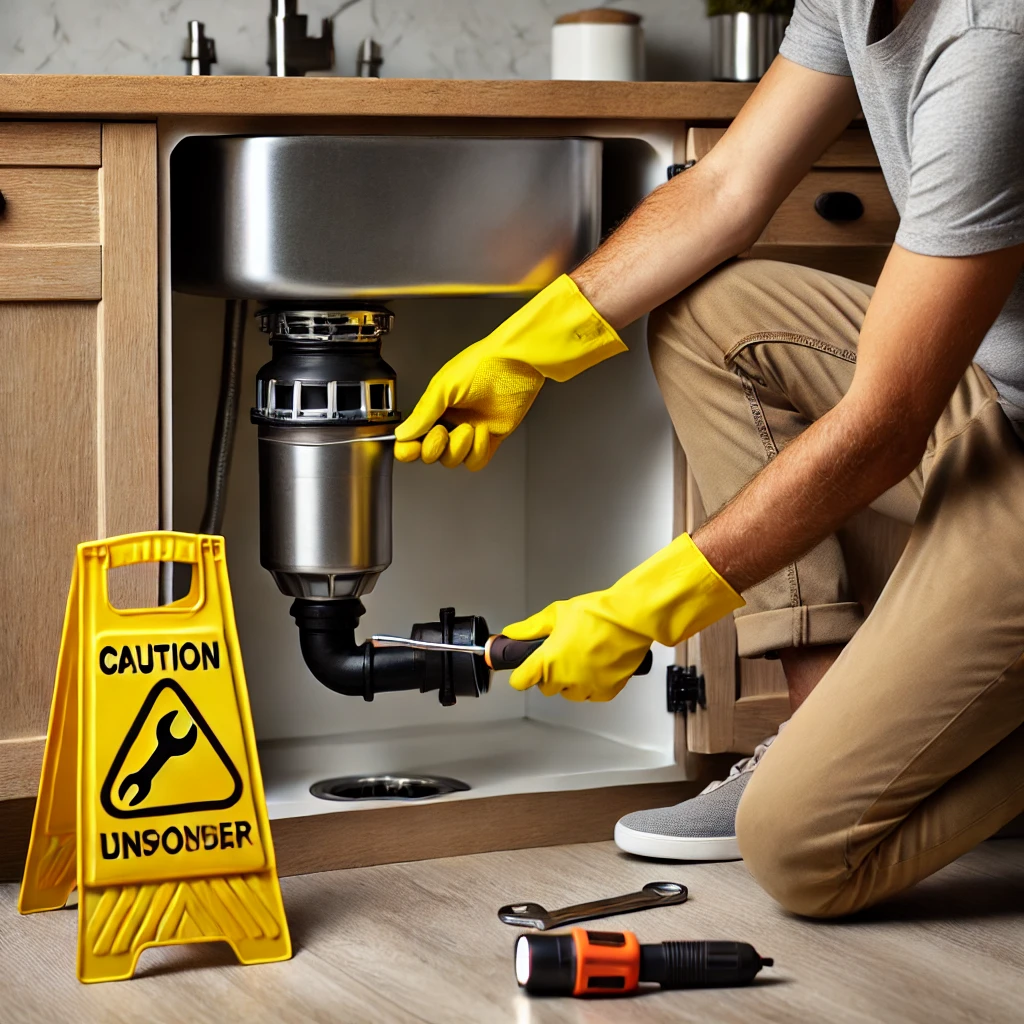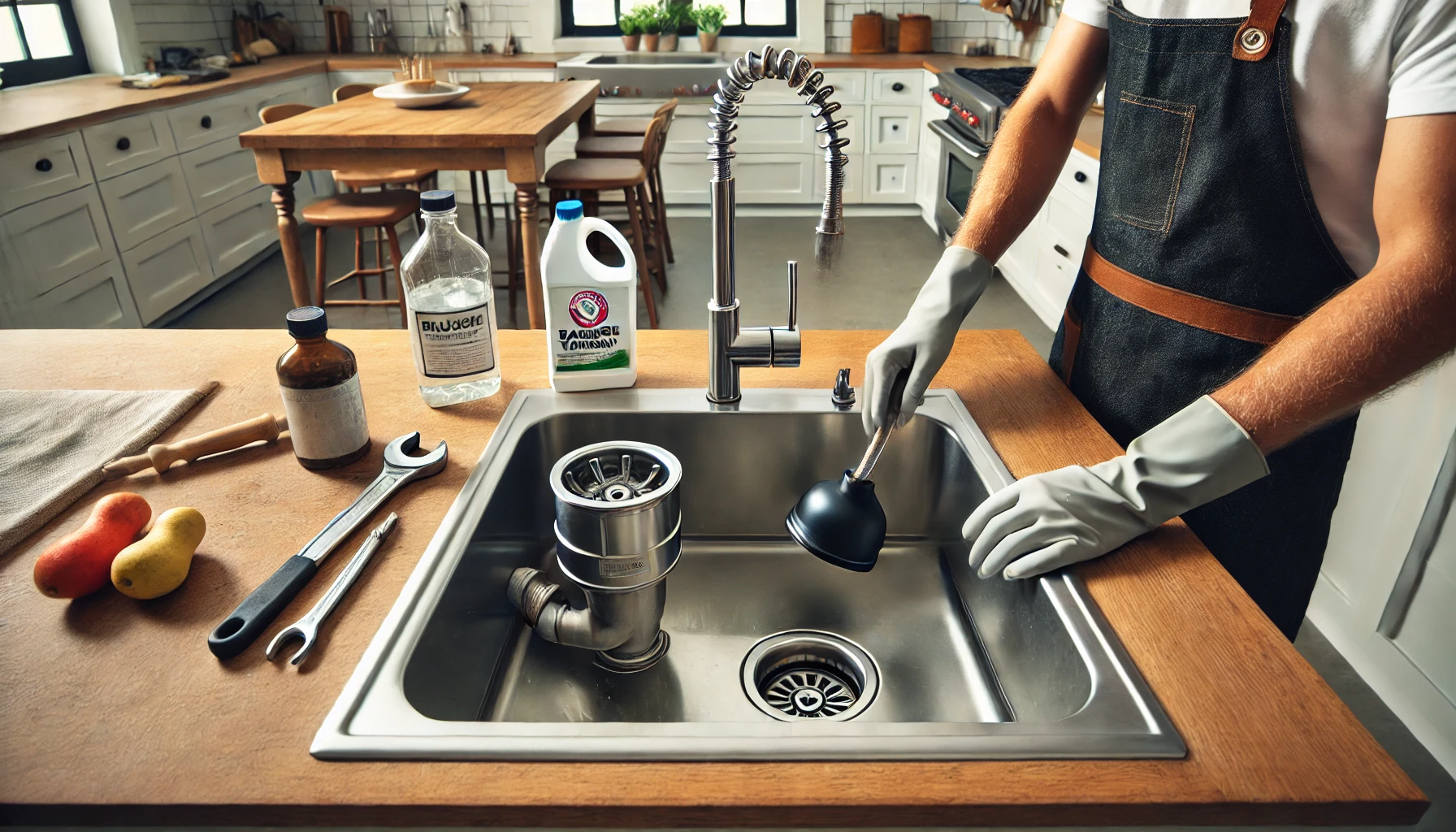A clogged kitchen sink can be frustrating, especially when it has a garbage disposal. Over time, food particles, grease, and debris can accumulate, causing water to back up. The good news is that you can usually fix the clog yourself without calling a plumber. This guide will walk you through a step-by-step process to unclog your sink safely and effectively.
Introduction
A kitchen sink with a garbage disposal is a convenient tool, but it can become clogged due to improper usage or buildup. When this happens, water may drain slowly or not at all. Instead of panicking, follow this comprehensive guide to restore your sink to working condition.
In this article, we’ll cover common causes of garbage disposal clogs, signs that indicate a blockage, and a step-by-step method to resolve the issue. Additionally, we will provide maintenance tips to prevent future problems.
Why Does a Kitchen Sink with a Garbage Disposal Get Clogged?
There are several reasons why your garbage disposal might clog. The most common causes include:
- Grease and Fat Buildup: Pouring grease or fat down the drain can lead to accumulation, which hardens over time and restricts water flow.
- Food Waste Accumulation: Certain foods like coffee grounds, eggshells, and fibrous vegetables (celery, onion skins, banana peels) can get stuck in the disposal blades.
- Foreign Objects: Small utensils, bottle caps, or other non-food items may accidentally fall into the disposal and obstruct the drain.
- Insufficient Water Usage: Running the garbage disposal without enough water can cause food particles to settle instead of flushing through the pipes.
- Aged or Dull Blades: Over time, garbage disposal blades can wear out, making it harder to break down food waste properly.
Common Signs of a Clogged Garbage Disposal
Identifying a clog early can prevent a bigger plumbing issue. Here are some warning signs that indicate your garbage disposal is clogged:
- Slow Drainage: If water is taking longer than usual to drain, it could mean there’s a blockage in the disposal or pipes.
- Standing Water in the Sink: When water pools in the sink and doesn’t drain, the clog might be severe.
- Unusual Noises: If you hear grinding, rattling, or humming noises without the disposal working properly, something may be jammed inside.
- Foul Odors: Rotting food stuck in the disposal or pipes can produce a bad smell.
- Disposal Won’t Turn On: If your disposal doesn’t start at all, it may be jammed or overheated.
Tools and Supplies You’ll Need
Before you start unclogging your garbage disposal, gather the following items:
- A plunger (specifically a sink plunger)
- Baking soda and vinegar (for natural cleaning)
- Boiling water
- Allen wrench (to manually rotate the disposal blades)
- Tongs or pliers (to remove visible debris)
- Bucket and towels (for catching water and preventing a mess)
- Drain snake or auger (for deeper clogs)
Having these tools ready will make the process easier and help you clear the clog efficiently.
Step 1: Safety First – Preparing to Unclog the Sink

Before attempting to clear the clog, it’s crucial to follow safety precautions. Garbage disposals have sharp blades, and improper handling can lead to injuries.
Turn Off the Garbage Disposal and Unplug It
The first step is to turn off the garbage disposal at the switch. For added safety, unplug it from the power source. If you can’t unplug it, locate the circuit breaker panel and switch off the corresponding breaker.
Never put your hands directly into the garbage disposal, even when it’s off. Instead, use tongs or pliers to remove objects safely.
Avoid Using Chemical Drain Cleaners
Many people resort to chemical drain cleaners, but these can be harmful to your pipes and garbage disposal. Harsh chemicals can corrode metal parts and damage the unit’s motor. Instead, use safer alternatives like baking soda and vinegar.
Remove Any Large Visible Debris
Use a flashlight to look inside the garbage disposal. If you see any large food particles, foreign objects, or debris, remove them using tongs or pliers. Avoid using your fingers to prevent accidental cuts from sharp disposal blades.
Read More: how to unclog a kitchen sink drain
Step 2: Try Simple Fixes to Clear the Clog
Sometimes, a minor blockage can be cleared using simple methods before resorting to more advanced techniques.
Method 1: Reset the Garbage Disposal
If your garbage disposal isn’t running or making a humming sound, it may need a reset.
Locate and Press the Reset Button
Most garbage disposals have a small red reset button located at the bottom. Press and hold the button for a few seconds, then release it. If the disposal was overheated, this should restore its function.
Test the Disposal with Water
After resetting, run cold water and turn the disposal on. If it operates normally, the issue is resolved. If not, move on to other methods.
Method 2: Use Boiling Water
Boiling water can help break up grease and minor clogs in your pipes.
How to Safely Pour Hot Water into the Drain
Boil a kettle of water and carefully pour it down the sink in two or three stages, allowing it to sit for a few minutes between pours.
When This Method Works Best
This technique works best for grease-related clogs but may not be effective for severe blockages. If the water remains stagnant, try another method.
Method 3: Plunge the Sink
A sink plunger can help dislodge a blockage by creating suction.
Choosing the Right Plunger
Use a flat-bottomed sink plunger rather than a toilet plunger, as it’s designed for kitchen drains.
Step-by-Step Guide to Plunging a Kitchen Sink
- Fill the sink with enough water to cover the plunger’s rubber cup.
- Place the plunger over the drain and ensure a tight seal.
- Pump up and down vigorously for 30 seconds.
- Check if the water drains. If not, repeat the process.
Method 4: Use Baking Soda and Vinegar
A natural and eco-friendly solution to clear clogs is a combination of baking soda and vinegar.
Mixing the Right Ratio for Maximum Effect
Pour ½ cup of baking soda followed by 1 cup of vinegar into the drain. Let it fizz for at least 15 minutes.
Letting It Sit Before Flushing with Hot Water
Once the fizzing stops, flush the drain with boiling water to clear out the debris. This method is excellent for mild to moderate clogs.
Step 3: Manually Remove the Clog
If the previous methods did not work, the clog may be deep inside the garbage disposal or drain pipes. In this case, you’ll need to manually remove the blockage.
Method 1: Check for Blockages Inside the Disposal
Sometimes, food debris or foreign objects can be lodged inside the disposal, preventing proper drainage.
Using Tongs or Pliers to Remove Debris
- Ensure the garbage disposal is completely turned off and unplugged.
- Use a flashlight to inspect inside the disposal.
- If you see any objects stuck inside, use tongs or pliers to pull them out carefully.
- Never use your hands, as the blades inside can be sharp.
How to Rotate the Blades Manually with an Allen Wrench
- Locate the hex hole at the bottom of the garbage disposal unit.
- Insert a ¼-inch Allen wrench into the hole.
- Turn the wrench back and forth to manually rotate the blades and dislodge any stuck debris.
- Once the movement becomes smooth, try running water and turning on the disposal to see if the clog is cleared.
Method 2: Clean the P-Trap
The P-trap (a curved pipe under the sink) can accumulate debris and cause blockages. Cleaning it can help clear stubborn clogs.
How to Locate and Remove the P-Trap
- Place a bucket under the P-trap to catch any trapped water.
- Use a wrench to loosen the nuts holding the P-trap in place.
- Carefully remove the P-trap and pour out any debris or standing water.
Cleaning and Reattaching the P-Trap Properly
- Use a bottle brush or old toothbrush to scrub the inside of the P-trap.
- Rinse it thoroughly with warm water.
- Reattach it securely, making sure the connections are tight.
- Run water to check if the sink drains properly.
Method 3: Use a Drain Snake or Auger
For deep clogs that are beyond the garbage disposal, a drain snake (plumber’s auger) can help remove blockages.
How to Insert and Rotate the Snake
- Insert the drain snake into the sink drain.
- Rotate the handle to push the snake further into the pipe.
- Keep turning until you feel resistance, indicating a blockage.
Pulling Out or Pushing Through the Clog
- If the snake catches debris, pull it out carefully.
- If it doesn’t pull anything out, push through the clog to break it apart.
- Run hot water to flush out any remaining particles.
Read More: how much to repaint kitchen cabinets
Prevention Tips: How to Avoid Future Clogs
Preventing clogs is easier than dealing with them. Follow these tips to keep your garbage disposal and sink working efficiently.
What Not to Put in a Garbage Disposal
Avoid putting the following items into the disposal:
- Grease, oil, and fat (they solidify and cause clogs).
- Fibrous foods like celery, corn husks, and banana peels.
- Starchy foods such as rice, pasta, and potato peels (they expand and create blockages).
- Coffee grounds and eggshells (they form sludge in the pipes).
- Non-food objects like utensils, plastic, or glass.
Best Practices for Keeping Your Disposal Running Smoothly
- Always run cold water when using the disposal to flush food particles down.
- Cut large food items into smaller pieces before putting them into the disposal.
- Avoid overloading the disposal with too much food at once.
- Run the disposal regularly to prevent rust or buildup.
Routine Maintenance Tips
- Once a week, pour a mixture of baking soda and vinegar into the disposal to keep it clean.
- Occasionally grind small ice cubes with lemon or orange peels to sharpen the blades and remove odors.
- Check the P-trap and drain pipes for buildup every few months.
When to Call a Professional Plumber
If DIY methods don’t work, it may be time to call a professional plumber.
Signs the Clog is Too Severe for DIY Fixes
- Water backs up in multiple drains in your home.
- The garbage disposal makes a loud humming or grinding noise but doesn’t work.
- You notice leaks under the sink, which could indicate a pipe issue.
- Persistent bad odors despite cleaning the disposal.
How to Know If Your Garbage Disposal Needs Replacement
- The unit is over 8-10 years old and frequently malfunctions.
- The disposal doesn’t turn on, even after resetting.
- Grinding blades are worn out and cannot break down food efficiently.
- The unit leaks or has visible damage.
If your garbage disposal is beyond repair, consider installing a new one to prevent future plumbing problems.
Conclusion About How to Unclog a Kitchen Sink with a Garbage Disposal
A clogged kitchen sink with a garbage disposal can be frustrating, but in most cases, you can fix it with simple DIY methods.
Quick Recap of the Steps
- Step 1: Safety First – Turn off the disposal, unplug it, and remove visible debris.
- Step 2: Try Simple Fixes – Reset the disposal, use boiling water, plunge the sink, or try baking soda and vinegar.
- Step 3: Manually Remove the Clog – Check inside the disposal, clean the P-trap, or use a drain snake.
Final Tips for a Fully Functional Kitchen Sink
- Avoid dumping grease, fibrous foods, or hard objects into the disposal.
- Run cold water when using the disposal to prevent buildup.
- Perform regular maintenance to keep your disposal working efficiently.
By following these steps, you can keep your kitchen sink and garbage disposal in top condition, saving money on repairs and avoiding unnecessary stress.

